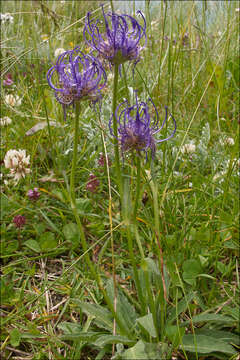Phyteuma-orbiculare_13

Description:
Phyteuma orbiculare L.Round-headed Rampion, DE: Kugel-RapunzelSlo.: glaviasti repuDat.: July 1. 2015Lat.: 46.43833 Long.: 13.63314Code: Bot_897/2015_IMG8771Habitat: stony grassland, road side, locally almost flat terrain, otherwise steep mountain slope, south aspect; full sun; calcareous, skeletal ground, exposed to direct rain, average precipitations ~ 3.000 mm/year, average temperature 1 - 3 deg C, elevation 1.800 m (5.900 feet), alpine phytogeographical region. Substratum: sandy soil.Place: Mt. Margart region, down-hill side bank or Mt. Mangart tool road before the last tunnel, East Julian Alps, Posoje, Slovenia EC Comment: The genus Phyteuma is easy to recognize. Its species have tubular violet flowers with typical shape of eagle's claws. To distinguish between species is less easy. Phyteuma orbiculare has 5 to 15 flowers joined in a round cluster at the end of the stem and is somewhat similar to two other high mountain Phyteuma species - Phyteuma sieberii and Phyteuma scheuchzeri.. The best trait to distinguish among them is their involucre (o whorl of bracts subtending a flower cluster). Phyteuma scheuchzeri has entire (not toothed, with continuous margin), very long and narrow bracts (5 -25 x longer than broad), which are much longer than radius of the flower cluster; Phyteuma sieberii has broad, and short, triangular bracts, which are coarsely and sharply toothed along the margin (dentate) and are approximately the same size as the radius of the flower cluster and Phyteuma orbiculare, which has generally entire bracts with occasionally only a few small teeth along the margin of the leaf base, and are 2 - 4 times longer than broad. The Phyteuma orbiculare is the tallest (up to 50 cm in the valleys) and Phyteuma sieberii the smallest (up to 15 cm). However, the hight of Phyteuma orbiculare varies widely (from 10 to 50 cm) and hence the size of the plants is not a reliable distinguishing trait.Phyteuma orbiculare is a common and widely distributed plant. It grows form low hills to alpine elevations and is spread over all regions of the Alps and other European mountains.Ref.:(1) M.A. Fischer, W. Adler, K. Oswald, Exkursionsflora fr sterreich, Liechtenstein und Sdtirol, LO Landesmuseen, Linz, Austria (2005), p 853.(2) A. Martini et all., Mala Flora Slovenije (Flora of Slovenia - Key) (in Slovenian), Tehnina Zaloba Slovenije (2007), p 632. (3) T. Wraber, 2 x Sto alpskih rastlin na Slovenskem (2x 100 Alpine Plants of Slovenia) (in Slovenian), Preernova druba (2006), p 170.(4) D. Aeschimann, K. Lauber, D.M. Moser, J.P. Theurillat, Flora Alpina, Vol. 2., Haupt (2004), p 336.
Included On The Following Pages:
- Life (creatures)
- Cellular (cellular organisms)
- Eukaryota (eukaryotes)
- Archaeplastida (plants)
- Chloroplastida (green plants)
- Streptophyta
- Embryophytes
- Tracheophyta (ferns)
- Spermatophytes (seed plants)
- Angiosperms (Dicotyledons)
- Eudicots
- Superasterids
- Asterids
- Asterales
- Campanulaceae (bellflowers)
- Phyteuma (Rampions)
- Phyteuma orbiculare (Round-headed Rampion)
This image is not featured in any collections.
Source Information
- license
- cc-by-nc-sa
- copyright
- Amadej Trnkoczy
- photographer
- Amadej Trnkoczy
- original
- original media file
- visit source
- partner site
- Flickr Group
- ID


